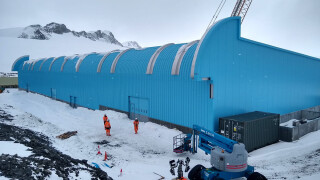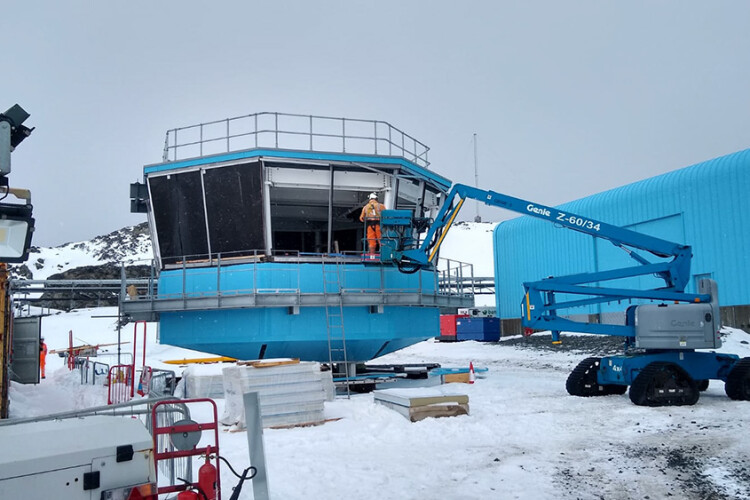There is only a narrow window of opportunity for construction teams working in Antarctica, one of the world’s most inhospitable locations. Back in December 2022, the team from contractor Bam started work on the latest phase of the Antarctic Infrastructure Modernisation Programme (AIMP), the UK government’s long-term investment programme to modernise its Antarctic research facilities.
Against a tight schedule, Bam installed the insulation and external cladding to make the new Discovery Building weather-proof and ready for the coming Antarctic winter.
Rothera Research Station is the UK’s largest Antarctic research and operations hub, supporting researchers from the UK and abroad. The Discovery Building will enable the UK to continue to deliver cutting-edge climate, biodiversity and ocean research and innovative science in Antarctica.
The decade-long AIMP programme includes construction of a new wharf at the Rothera Research Station for the RRS Sir David Attenborough and construction of the Discovery Building. When complete, the new building will replace several older buildings at the station and support science in the region for at least the next 50 years.
Last year, the team completed the Discovery Building’s structural frame. This season’s work has focused on making the structure weathertight and installing a new operations tower.
Bam has now completed four years of construction work on the new building. Battling harsh weather conditions, the team of around 54 on-site construction workers has completed this season’s programme of work on schedule and in time for their planned departure at the end of April.
The large (4,500m2) two-storey Discovery Building will enable the British Antarctic Survey’s scientific support and operations functions to work together under one roof for the first time.
The new facility is designed to make sure the long-term impact on the environment is minimal and meets British Antarctic Survey’s net zero ambitions by 2040.
A combined heat and power plant is expected to cut carbon emissions for the entire research station at Rothera by 25%. This, along with photovoltaic solar panels, a thermally-efficient building envelope and triple glazing will make the building an exemplar for energy efficiency, claims BAS.

The new Discovery Building has a specially-designed wind deflector to minimise the accumulation of snow around the building. The new operations tower provides 360o views of the runway, wharf and station buildings.
Bam is working with engineer design consultant Sweco and Hugh Broughton Architects. Ramboll is acting as technical advisor with Norr Architects providing concept design, OFR providing fire consultancy and Turner & Townsend providing cost and commercial advice.
Stewart Craigie, technical director at Sweco, said: “The highlight of this season’s construction has been achieving the wind and weathertight status with the completion of the envelope and the installation of the operations tower. Having personally witnessed the initiation of this activity it is great to see how the Discovery Building is developing its character in the Antarctic landscape.”
His colleague, architect Hugh Broughton, added: “The Discovery Building will become a remarkable platform for polar science. The sustainable multi-functional facility will provide flexible space to support BAS’s activities and enhance the well-being of people living and working in an extreme, remote location.”
The team will return in November 2023 to begin the next phase of construction. The building is due to be completed in 2025.

The bigger picture
The improvements taking place at the Rothera Research Station are part of a much wider government undertaking to modernise its Arctic and Antarctic research facilities.
So far the government has allocated £670m for polar infrastructure improvements. Around £200m has already been spent on the new RSS Sir David Attenborough research vessel.
The projects are commissioned by the Natural Environment Research Council, part of UK Research & Innovation, and funded by the Department for Business, Energy, and Industrial Strategy.
Besides the modernisation of the Rothera Research Station and the new research ship, the project includes:
• an upgrade of King Edward Point wharf and slipway on South Georgia to make sure the new ship can moor safely and resupply the station,
• modernisation of Bird Island Research Station on South Georgia to increase storage and improve energy use,
• modernisation of the summer-only Signy Research Station, to include a longer, more robust jetty, better storage and handling facilities and improved living spaces, and
• relocation of the Halley Research Station, to prevent an ice chasm separating the station from the rest of the Halley research site on the Brunt Ice Shelf.
Got a story? Email news@theconstructionindex.co.uk



